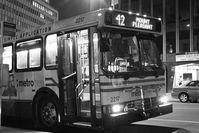Relocate bus stops to save time

Photo by matthewbradley on Flickr
In the Washington area, most bus stops are located on the “near” side of intersections. While there are some advantages to this type of location, relocating stops at certain intersections could speed bus trips and increase passenger safety.
One problem with buses on crowded streets is that at signalized intersections, traffic backed up from the signal keeps buses from reaching the stop. When the light turns green, and traffic begins to move, the bus reaches the stop, but misses the light while passengers board and alight.
One example of near side stop problems is in Columbia Heights. The southbound 50s line stop at Park Road can be a source of considerable delay to passengers. Southbound buses often get stopped in traffic a block or more north of the stop. When the light turns green for 14th Street southbound, traffic begins to move.
During the morning rush, drivers have about 45 seconds before the light changes red. That means that the bus has 45 seconds to reach the stop, pull out of traffic, open its doors, kneel, allow passengers to alight, allow passengers to board and pay the fare, close its doors, re-enter traffic, and clear the light… or wait approximately 1 minute and 45 seconds for the light to turn green for southbound traffic again.
If it takes, say, 50 seconds to do all that, then the bus loses 1 minute 40 seconds just sitting there, not moving because it missed the light by 5 seconds, not because it’s still boarding passengers.
When the stop is on the near side, the bus can’t leave the stop once passengers are done boarding and alighting, whereas, the bus would be able to depart immediately if the stop was on the “far” side. This is the case one block further south at Irving Street. In this instance, the bus stop is on the far side of the intersection because that’s where the Metrorail exit is for Columbia Heights station. Signal delays are less pronounced in this instance since buses never have to wait for more than one light because of boarding or alighting passengers - although congestion could cause that problem.
Moving the stop to the far side would also increase safety. Crossing in front of the bus makes pedestrians less visible to drivers passing the bus. The Transit Cooperative Research Program (TCRP) and others encourage transit agencies to place stops on the far side of intersections because alighting passengers and pedestrians are encouraged to cross behind the bus, and are therefore more visible to motorists.
The TCRP lists the advantages and disadvantages of different bus stop placements. Among the advantages to far side bus stops are:
- Minimization of conflict between right-turning vehicles and stopped buses
- Additional right turn capacity
- Minimization of sight-distance problem at intersections
- Encourages pedestrians to cross behind the bus
- Shortens deceleration distances for buses, since the intersection can be used
- Bus drivers are able to use the gaps in traffic created by the signal to reenter traffic
- More than one bus at a time can queue through the intersection
- Buses may be stopped at a red light before reaching the stop
- Could increase the number of rear-end accidents, since drivers don’t expect the bus to stop again after clearing the signal
- If no bus pull-off is provided, it can cause traffic to queue through the intersection
In other cases, it might not be as important to relocate stops. When queueing traffic is not likely to block the stop, near side stops could be sufficient from an operational standpoint, however it still presents safety problems for crossing pedestrians.
As WMATA goes about its bus stop optimization program, they should give consideration to relocating some stops in the name of safety and service optimization.

